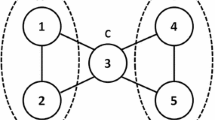Abstract
In this article, a two-level regression model is imposed on the ability parameters in an item response theory (IRT) model. The advantage of using latent rather than observed scores as dependent variables of a multilevel model is that it offers the possibility of separating the influence of item difficulty and ability level and modeling response variation and measurement error. Another advantage is that, contrary to observed scores, latent scores are test-independent, which offers the possibility of using results from different tests in one analysis where the parameters of the IRT model and the multilevel model can be concurrently estimated. The two-parameter normal ogive model is used for the IRT measurement model. It will be shown that the parameters of the two-parameter normal ogive model and the multilevel model can be estimated in a Bayesian framework using Gibbs sampling. Examples using simulated and real data are given.
Similar content being viewed by others
References
Adams, R.J., Wilson, M., & Wu, M. (1997). Multilevel item response models: An approach to errors in variable regression.Journal of Educational and Behavioral Statistics, 22, 47–76.
Albert, J.H. (1992). Bayesian estimation of normal ogive item response curves using Gibbs sampling.Journal of Educational Statistics, 17, 251–269.
Béguin, A.A., & Glas, C.A.W. (1998).MCMC estimation of multidimensional IRT models (Technical Report No. 98-14). Twente, The Netherlands: University of Twente, Faculty of Educational Science and Technology.
Bock, R.D., & Aitkin, M. (1981). Marginal maximum likelihood estimation of item parameters: Application of an EM algorithm.Psychometrika, 46, 443–459.
Box, G.E.P., & Tiao, G.C. (1973).Bayesian inference in statistical analysis. Reading, MA: Addison-Wesley Publishing.
Bradlow, E.T., Wainer, H., & Wang, X. (1999). A Bayesian random effects model for testlets.Psychometrika, 64, 153–168.
Bryk, A.S., & Raudenbush, S.W. (1992).Hierarchical linear models. Newbury Park, CA: Sage Publications.
Bryk, A.S., Raudenbush, S.W., & Congdon, R.T. (1996).Hlm for Windows. Chicago, IL: Scientific Software International.
de Leeuw, J., & Kreft, I.G.G. (1986). Random coefficient models for multilevel analysis.Journal of Educational and Behavioral Statistics, 11, 57–86.
Doolaard, S. (1999).Schools in change or schools in chains. Unpublished doctoral dissertation, University of Twente, The Netherlands.
Gelfand, A.E., Hills, S.E., Racine-Poon, A., & Smith, A.F.M. (1990). Illustration of Bayesian inference in normal data models using Gibbs sampling.Journal of the American Statistical Association, 85, 972–985.
Gelman, A., Carlin, J.B., Stern, H.S., & Rubin, D.B. (1995).Bayesian data analysis. London, UK: Chapman & Hall.
Gelman, A., Meng, X-L., & Stern, H.S. (1996). Posterior predictive assessment of model fitness via realized discrepancies.Statistica Sinica, 6, 733–807.
Geman, S., & Geman, D. (1984). Stochastic relaxation, Gibbs distribution, and the Bayesian restoration of images.IEEE Transactions on Pattern Analysis and Machine Intelligence, 6, 721–741.
Gibbons, R.D., & Hedeker, D.R. (1992). Full-information bi-factor analysis.Psychometrika, 57, 423–463.
Glas, C.A.W., Wainer, H., & Bradlow, E.T. (2000). MML and EAP estimation in testlet-based adaptive testing. In W.J. van der Linden & C.A.W. Glas (Eds.),Computerized adaptive testing: Theory and practice (pp. 271–287). Boston, MA: Kluwer Academic Publishers.
Goldstein, H. (1995).Multilevel statistical models (2nd ed.). London: Edward Arnold.
Hoijtink, H., & Boomsma, A. (1995). On person parameter estimation in the dichotomous Rasch model. In G.H. Fischer & I.W. Molenaar (Eds.),Rasch models: Foundations, recent developments and applications (pp. 53–68). New York, NY: Springer.
Hoijtink, H., & Molenaar, I.W. (1997). A multidimensional item response model: Constrained latent class analysis using the Gibbs sampler and posterior predictive checks.Psychometrika, 62, 171–189.
Lindley, D.V., & Smith, A.F.M. (1972). Bayes estimates for the linear model.Journal of the Royal Statistical Society, Series B, 34, 1–41.
Longford, N.T. (1993).Random coefficient models. New York, NY: Oxford University Press.
Mathsoft, Data Analysis Products Division. (1999).S-Plus 2000 programmer's guide [computer program and software manual]. Seattle, WA: Author.
Mislevy, R.J. (1986). Bayes model estimation in item response models.Psychometrika, 51, 177–195.
Mislevy, R.J., & Bock, R.D. (1989). A hierarchical item-response model for educational testing. In R.D. Bock (Eds.),Multilevel analysis of educational data (pp. 57–74). San Diego, CA: Academic Press.
Morris, C.N. (1983). Parameteric empirical Bayes inference: Theory and applications (with discussion).Journal of the American Statistical Association, 78, 47–65.
O'Hagan, A. (1995). Fractional Bayes factors for model comparison.Journal of the Royal Statistical Society, Series B, 57, 99–138.
Patz, R.J., & Junker, B.W. (1999a). A straightforward approach to Markov chain Monte Carlo methods for item response models.Journal of Educational and Behavioral Statistics, 24, 146–178.
Patz, R.J., & Junker, B.W. (1999b). Applications and extensions of MCMC in IRT: Multiple item types, missing data, and rated responses.Journal of Educational and Behavioral Statistics, 24, 342–366.
Raudenbush, S.W. (1988). Educational applications of hierarchical linear models: A review.Journal of Educational Statistics, 13, 85–116.
Roberts, G.O., & Sahu, S.K. (1997). Updating schemes, correlation structure, blocking and parametrization for the Gibbs sampler.Journal of the Royal Statistical Society, Series B, 59, 291–317.
Rubin, D.B. (1981). Estimation in parallel randomized experiments.Journal of Educational Statistics, 6, 377–400.
Seltzer, M.H. (1993). Sensitivity analysis for fixed effects in the hierarchical model: A Gibbs sampling approach.Journal of Educational Statistics, 18, 207–235.
Seltzer, M.H., Wong, W.H., & Bryk, A.S. (1996). Bayesian analysis in applications of hierarchical models: Issues and methods.Journal of Educational and Behavioral Statistics, 21, 131–167.
Wainer, H., Bradlow, E.T., & Du, Z. (2000). Testlet response theory: An analog for the 3pl model useful in testlet-based adaptive testing. In W.J. van der Linden & C.A.W. Glas (Eds.),Computerized adaptive testing: Theory and practice (pp. 245–269). Boston, MA: Kluwer Academic Publishers.
Wei, G.C.G., & Tanner, M.A. (1990). A Monte Carlo implementation of the EM algorithm and the poor man's Data Augmentation algorithms.Journal of the American Statistical Association, 85, 699–704.
Zimowski, M.F., Muraki, E., Mislevy, R.J., & Bock, R.D. (1996).Bilog MG, multiple-group IRT analysis and test maintenance for binary items. Chicago, IL: Scientific Software International.
Author information
Authors and Affiliations
Corresponding author
Rights and permissions
About this article
Cite this article
Fox, JP., Glas, C.A.W. Bayesian estimation of a multilevel IRT model using gibbs sampling. Psychometrika 66, 271–288 (2001). https://doi.org/10.1007/BF02294839
Received:
Revised:
Issue Date:
DOI: https://doi.org/10.1007/BF02294839




